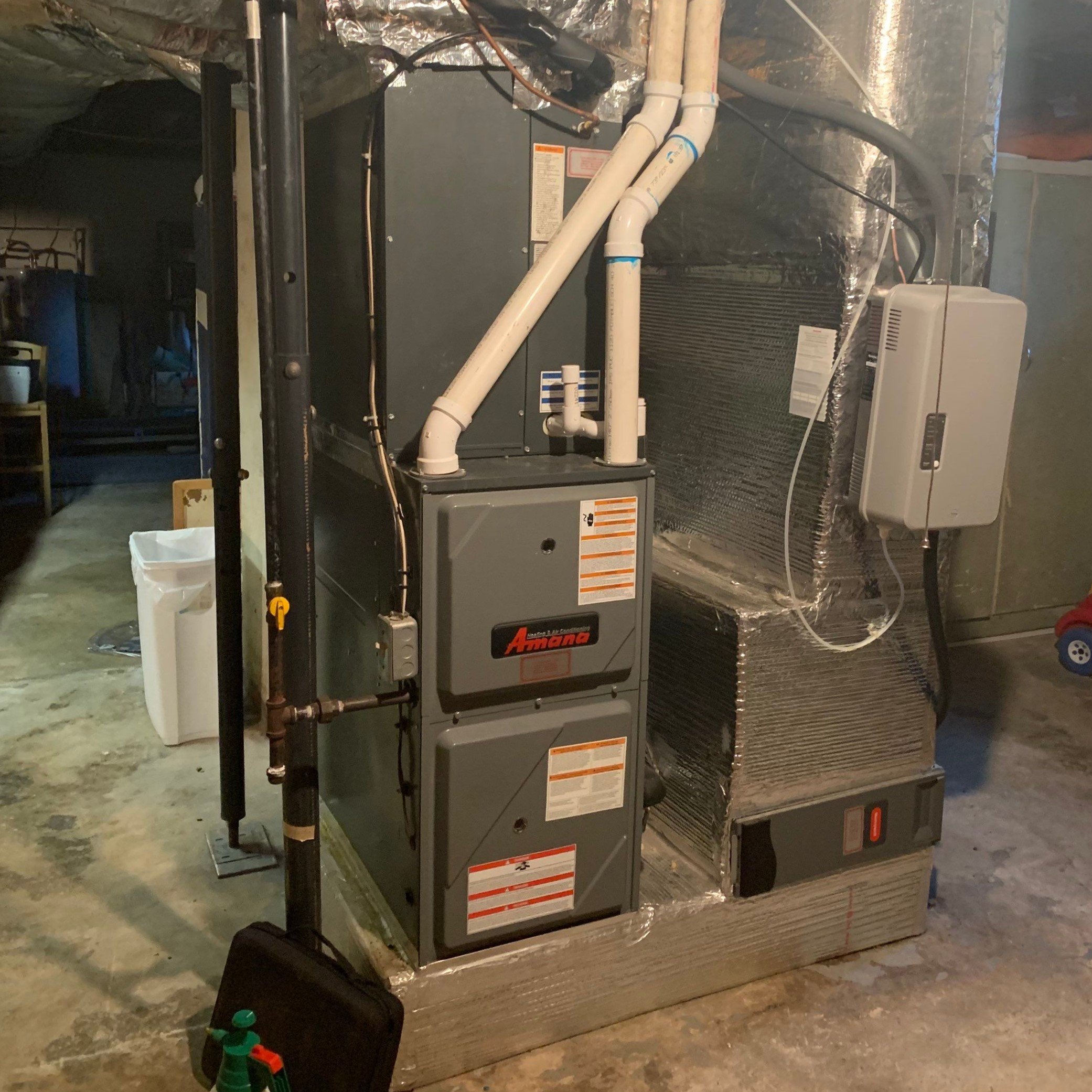High-efficiency gas furnace
This article wraps up our information on furnace efficiency ratings and categories. This should give homeowners a better understanding of their heating system. You have insight into the limitations that are placed on installation, furnace location, vent piping, condensate drains, and integration with your cooling system.
Gas furnace Categories and Efficiency Rating
From our last article, most major HVAC brands offer two natural gas furnace types:
Mid-efficiency Category I fan-assisted
High-efficiency Category IV condensing-type furnace
The minimum energy efficiency for mid-efficiency furnaces is 80 percent annual fuel utilization efficiency (AFUE). 80 percent of furnaces have a flue gas temperature at least 140F above the dew point of the flue gas.
A high-efficiency furnace has flue gas temperatures below the dew point which permits condensation within the furnace to pick up extra latent heat.
Category IV Natural Gas Furnace
An appliance with a positive vent static pressure and vent gas temperature less than 140F above the flue-gas dew point that can cause excessive condensate production in the vent.
Category IV Higher Efficiency Gas Furnace
Category IV furnaces (high-efficiency furnaces) are very common. They are the 90 percent AFUE condensing furnaces. PVC can be used as a vent material because the flue gas is relatively cool.
High-Efficiency Gas Furnaces (90+ Percent AFUE)
High-efficiency, condensing-type gas furnaces are rated at 90 percent annual fuel utilization efficiency (AFUE) or better. They differ from a mid-efficiency model in that a second heat exchanger is added to extract more heat from the flue.
Two heat exchangers
The additional surface of the secondary heat exchanger causes moisture in the exhaust gas to condense. Additional heat energy is absorbed from the flue gas and the heat is rejected by the condensing moisture.
This design reduces the volume and temperature of the exhaust gas. This allows the use of smaller vent pipes and simplified venting arrangements. The lower temperature of the flue gas allows the use of PVC vent piping and vent outlets can be run to the side of a building if needed.
A condensate line is needed to drain the condensed water. The drain needs to be run to a suitable drain location. These can be combined with the air conditioning cooling drains. The condensate could contain some contaminants. Follow local codes to ensure drains are properly disposed of.
Product Data (90+ Percent AFUE Furnaces)
Product data for a high-efficiency gas furnace has information similar to that of the 80 percent AFUE models, with some additions. Condensing-type furnaces require a drain for condensate. Basic nameplate information:
Minimum gas-line pressure
Maximum gas-line pressure
Manifold gas pressure
Temperature rise
Electrical characteristics
Input capacity
Output capacity
Fresh air intake
Most high-efficiency furnaces have a fresh air intake to provide combustion air to the furnace from the outside so that the gas furnace doesn't draw air out of the house. This also prevents household chemicals from being drawn into the furnace. Your high-efficiency gas furnace will have two PVC vent lines, a fresh air intake, and a flue vent.
Maximum vent length and elbows
The draft-inducer fan for high-efficiency furnaces is not very strong and doesn't create very much positive pressure. Long runs and elbows can reduce flow through the vent and lead to the furnace shutting off on the draft safety switch. When a new furnace is installed, technicians should follow installation instructions for the maximum vent length and number of elbows allowable.
Freeze protection
Armaflex-type insulation should be used on flue vent piping that is exposed to temperatures below freezing. The length of an exposed insulated vent pipe should be minimized per installation instructions.
Traps and low places
Vent piping should not have traps or low places where water can collect. This could block the flue vent causing the furnace to shut down. In general, the vent should slope back toward the furnace. The vent can be installed horizontally if the installation instructions are followed.
Combustion Condensate Piping
The condensate drain line should have a trap. However, a condensate trap is built into many of today's furnaces. This eliminates the need for another trap. A typical condensing furnace drain will be .5-in schedule 40 PVC.
Furnace condensate can be mildly acidic, typically in the pH range of 3.2 to 4.5. Not all condensate pumps are approved for use on condensing furnace drains. If a condensate pump is needed, use a pump that is approved for condensing furnaces. Pumps should have an overflow switch to avoid overflow in the case of pump failure or a stopped drain.
A furnace condensate drain and an evaporator condensate drain should not normally be combined. The pressure in an up-flow cooling coil plenum can pressurize the drain and the secondary heat exchanger. This could stop the furnace from draining and cause the furnace to lock out on its pressure-switch safety.
If the furnace and air-conditioner drains are combined, the air-conditioning drain must have an external trap before the furnace drain connection. The drain should be .75-in PVC when combined with the air-conditioner drain. When draining inside, the drain should run into an open or vented drain as close to the HVAC system as possible. Caution should be taken in cold weather because the drain pipe may freeze and prohibit draining.
A secondary drain pan should be used under condensing furnaces in an attic or over a finished ceiling to prevent damage to the ceiling in the event of a plugged drain.
Variable-Capacity Furnaces
Manufacturers have two primary means of offering a premium high-efficiency furnace, two-stage combustion and ECM blower motors.
Two-stage combustion
One of the most wasteful periods of a furnace operation cycle is the warm-up time. During warm-up, the burners are firing and the fan is not on. Increased furnace cycling wastes heat energy, reduces efficiency and raises energy bills.
Furnace run time can be extended and cycling can be reduced by using a two-stage gas valve. One low fire, the furnace runs at approximately half capacity. At half capacity, the furnace will run for longer periods in milder weather.
On high fire, the gas valve will fully open and the furnace will operate at full capacity. On low fire, the gas valve operates at a lower pressure and less gas goes into the burners. On high fire, the manifold pressure is normal and the furnace runs at full capacity.
Two-stage furnaces are available in both 80 percent and 90 percent AFUE ratings.
ECM blower motors
While two-stage furnaces offer customers a means of saving money on their gas energy bill. ECM motors save on your electrical power usage.
ECM blower motors offer many operational advantages and are more efficient than standard blowers. Variable-speed ECM blowers work well with two-stage furnaces. They deliver the correct amount of airflow for both low-fire and high-fire operations consuming less electricity.
Full-modulating furnaces are now available from most manufacturers and can effectively provide up to one hundred stages of capacity.
Product Data (Variable-capacity Furnaces)
The distinguishing features of variable capacity furnaces are:
Two-stage gas valves
Two-speed induced-draft fan
Two-draft proving switches
Two-stage thermostat.
Two-stage gas valve
The two-stage gas valve is the primary component that makes variable-speed furnaces possible. It has settings for both the low-fire and high-fire manifold pressures. The British thermal unit (BTU) value of the gas and the altitude of the installation determine the correct manifold pressures.
Inducer draft motor and draft switches
The induced-draft fan motor must adjust as needed for both the low-fire and high-fire settings. This is done using a multispeed PSC motor or ECM motor. Two draft switches are also needed—one for low fire and one for high fire.
Two-stage thermostat
Finally, a two-stage thermostat is needed to operate the furnace.
Summary
Understanding your heating and air conditioning ratings and design will help you make better decisions for the comfort of your home. You will be able to weigh upfront costs against monthly energy bills. The purchase price of the right furnace makes sense when compared to the savings on energy costs.




